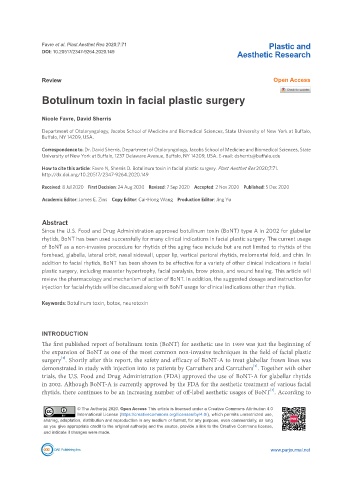Page 839 - Read Online
P. 839
Favre et al. Plast Aesthet Res 2020;7:71 Plastic and
DOI: 10.20517/2347-9264.2020.149 Aesthetic Research
Review Open Access
Botulinum toxin in facial plastic surgery
Nicole Favre, David Sherris
Department of Otolaryngology, Jacobs School of Medicine and Biomedical Sciences, State University of New York at Buffalo,
Buffalo, NY 14209, USA.
Correspondence to: Dr. David Sherris, Department of Otolaryngology, Jacobs School of Medicine and Biomedical Sciences, State
University of New York at Buffalo, 1237 Delaware Avenue, Buffalo, NY 14209, USA. E-mail: dsherris@buffalo.edu
How to cite this article: Favre N, Sherris D. Botulinum toxin in facial plastic surgery. Plast Aesthet Res 2020;7:71.
http://dx.doi.org/10.20517/2347-9264.2020.149
Received: 8 Jul 2020 First Decision: 24 Aug 2020 Revised: 7 Sep 2020 Accepted: 2 Nov 2020 Published: 5 Dec 2020
Academic Editor: James E. Zins Copy Editor: Cai-Hong Wang Production Editor: Jing Yu
Abstract
Since the U.S. Food and Drug Administration approved botulinum toxin (BoNT) type A in 2002 for glabellar
rhytids, BoNT has been used successfully for many clinical indications in facial plastic surgery. The current usage
of BoNT as a non-invasive procedure for rhytids of the aging face include but are not limited to rhytids of the
forehead, glabella, lateral orbit, nasal sidewall, upper lip, vertical perioral rhytids, melomental fold, and chin. In
addition to facial rhytids, BoNT has been shown to be effective for a variety of other clinical indications in facial
plastic surgery, including masseter hypertrophy, facial paralysis, brow ptosis, and wound healing. This article will
review the pharmacology and mechanism of action of BoNT. In addition, the suggested dosage and instruction for
injection for facial rhytids will be discussed along with BoNT usage for clinical indications other than rhytids.
Keywords: Botulinum toxin, botox, neurotoxin
INTRODUCTION
The first published report of botulinum toxin (BoNT) for aesthetic use in 1989 was just the beginning of
the expansion of BoNT as one of the most common non-invasive techniques in the field of facial plastic
[1]
surgery . Shortly after this report, the safety and efficacy of BoNT-A to treat glabellar frown lines was
[2]
demonstrated in study with injection into 18 patients by Carruthers and Carruthers . Together with other
trials, the U.S. Food and Drug Administration (FDA) approved the use of BoNT-A for glabellar rhytids
in 2002. Although BoNT-A is currently approved by the FDA for the aesthetic treatment of various facial
rhytids, there continues to be an increasing number of off-label aesthetic usages of BoNT . According to
[3]
© The Author(s) 2020. Open Access This article is licensed under a Creative Commons Attribution 4.0
International License (https://creativecommons.org/licenses/by/4.0/), which permits unrestricted use,
sharing, adaptation, distribution and reproduction in any medium or format, for any purpose, even commercially, as long
as you give appropriate credit to the original author(s) and the source, provide a link to the Creative Commons license,
and indicate if changes were made.
www.parjournal.net

